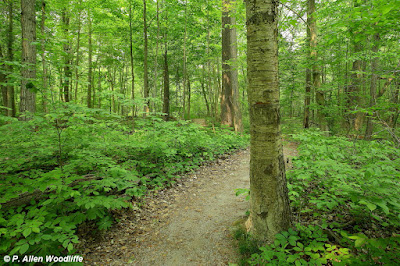Perhaps the three different habitats in the title are an odd mix, but the reality is those are what I have been exploring lately, and for good reason which hopefully will become apparent as this blog post unfolds.
Forests are fascinating at any time of year, but with the lush green growth, they are extra inspiring to me, especially on an overcast day with no wind. They have an atmosphere like nowhere else, and one feels a little overwhelmed in a good way, when one takes the time to see the multitude shades of green and gray, and tries to make sense of every little detail laid out before you. The forest has so many stories to share. Given that the main birding season is over, the trails are a bit quieter, so bird and insect song is subdued but noticeable. A small photo about 3" X 5" really doesn't do the area justice. If you click on the images, it will make them a bit larger, but still not quite like the real thing.You really have to get out and immerse yourself in the setting to appreciate what it has to offer, in my opinion.
These next two photos show Winterberry, not a common shrub, but a bit widespread in damp areas. It will have bright red berries in the fall, which are readily consumed by migrating warblers and thrushes.
There are birds around, to be sure, such as this Acadian Flycatcher, which seems to be persistent along one stretch of the Tuliptree Trail but I am not sure it has found a mate....
...and Eastern Wood-Pewees are pretty reliably encountered.
House Wrens, too, can often be heard, and sometimes seen. This one was half of a pair of them investigating a cavity in a tree stub. The presumed male, shown here, seems to be half asleep while bubbling away!
A pair of Prothonotary Warblers can occasionally be cooperative along this trail. More on this species in a future post.
I have recently been out to a couple of grassland areas, in northeast Chatham-Kent and southeastern Lambton as part of a Grassland Bird Assessment project. Parts of them were at quite an early stage of growth, and didn't have a lot of grassland bird activity. No doubt the vegetation was much shorter when the grassland birds arrived, making it less desirable.
Bobolink was one of the target species, and there were a few around, but often partially hidden in the grass which made locking the focus on the bird difficult.....
...so I had to wait for them to be in flight, and in spite of their somewhat erratic flight, was able to capture a few photos.
Common Yellowthroats were fairly widespread.....
...and a few females popped into view from time to time.
There were a few butterflies flitting around, such as this Common Wood-Nymph. There were others, but I didn't want to get too distracted by them since birds were my main target.
I also spent some time at places where I could access either the Thames or the Sydenham rivers, sort of in preparation for an upcoming project entitled Natural Treasures of Chatham-Kent. More on that in a future post.
A shrub that was in fine flower on one occasion was Ninebark, shown in the next two photos.These two rivers have an exceptional diversity of mussels, many of which are at risk, such as these next two species.
 |
| Deer Toe Mussel |
 |
| Deer Toe Mussel |
 |
| Pimpleback |
 |
| Pimpleback |
Damselflies and dragonflies are also well represented.
 |
| Ebony Jewelwing |
 |
| Calico Pennant |
If you would like to subscribe, or unsubscribe, to Nature Nuggets, send an email to: prairietramper@gmail.com























No comments:
Post a Comment